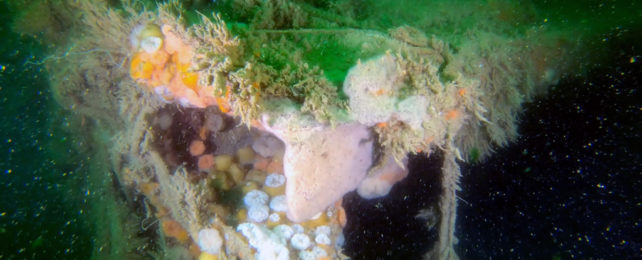There's a certain romance and mystique associated with shipwrecks when seen as ancient artifacts hiding in the gloom. Where we might imagine untold treasures locked behind their rusting hulls, in reality it's often a mess of old fuel, corroded bombs, and toxic waste.
A new study analyzing the World War II shipwreck V-1302 John Mahn, in the Belgian part of the North Sea, has found substances leaking from the old wreck are still influencing the surrounding microbiology and geochemistry some 80 years after the ship sank to the sea floor.
Considering there are thousands of similar wrecks in the North Sea alone, the cumulative impact on marine life is potentially huge – especially considering the munitions and hazardous materials that are often stored on military vessels.
"We wanted to see if old shipwrecks in our part of the sea were still shaping the local microbial communities and if they were still affecting the surrounding sediment," says microbial ecologist Josefien Van Landuyt, from Ghent University in Belgium. "This microbial analysis is unique within the project."
The V-1302 John Mahn started out as a German fishing trawler before being converted into a patrol boat during the war. It was sunk close to the Belgian coast in 1942 by the British Royal Air Force, as part of the Channel Dash operation.
Researchers took samples of the steel hull and the sediment at twelve different points close to the wreck and at increasing distances away from it, to see how far any possible contamination might be spreading.
The concentration of toxic pollutants around the vessel varied depending on distance: there was evidence of heavy metals (like nickel and copper), arsenic, explosive compounds, and polycyclic aromatic hydrocarbons or PAHs (chemicals that occur naturally in coal, crude oil and gasoline).
As might be expected, concentrations of these pollutants increased with proximity to the ship. The highest metal concentrations were found in the sample closest to the ship's coal bunker, for example.
These concentrations impact the surrounding microbial life, the researchers found. Microbes such as Rhodobacteraceae and Chromatiaceae, known to degrade PAHs, were found in the samples that had the highest concentrations of pollutants. Sulfate-reducing bacteria was found on the hull, most likely corroding it.
"Although we don't see these old shipwrecks, and many of us don't know where they are, they can still be polluting our marine ecosystem," says Van Landuyt.
"In fact, their advancing age might increase the environmental risk due to corrosion, which is opening up previously enclosed spaces. As such, their environmental impact is still evolving."
The researchers suggest that there's much more to discover in terms of the influence of shipwrecks on underwater ecosystems – yet another example of how human activity is changing the natural world around us.
Work continues to discover what shipwrecks can teach us about the past and how they're affecting the oceans in the present – and the team behind the current study is keen to use the same techniques on other shipwrecks in the area.
"The general public is often quite interested in shipwrecks because of their historical value, but the potential environmental impact of these wrecks is often overlooked," says Van Landuyt.
"We only investigated one ship, at one depth, in one location. To get a better overview of the total impact of shipwrecks on our North Sea, a large number of shipwrecks in various locations would have to be sampled."
The research has been published in Frontiers in Marine Science.
